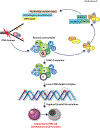NK Cell Development and Function in Patients with Fanconi Anemia
- PMID: 34348001
- PMCID: PMC11536512
- DOI: 10.1615/CritRevImmunol.2021037644
NK Cell Development and Function in Patients with Fanconi Anemia
Abstract
Fanconi anemia (FA) is an inherited disorder characterized by diverse congenital malformations, progressive pancytopenia, and predisposition to hematological malignancies and solid tumors. The role of the Fanconi anemia pathway in DNA repair mechanisms and genome instability is well studied. However, the consequences of inherited mutations in genes encoding the FA proteins and the acquired mutations due to impaired DNA repair complex in immune cells are far from understood. Patients with FA show bone marrow failure (BMF) and have a higher risk of developing myelodysplasia (MDS) or acute myeloid leukemia (AML) which are directly related to having chromosomal instability in hematopoietic stem cells and their subsequent progeny. However, immune dysregulation can also be seen in FA. As mature descendants of the common lymphoid progenitor line, NK cells taken from FA patients are dysfunctional in both NK cell-mediated cytotoxicity and cytokine production. The molecular bases for these defects are yet to be determined. However, recent studies have provided directions to define the cause and effect of inherited and acquired mutations in FA patients. Here, we summarize the recent studies in the hematopoietic dysfunction, focusing on the impairment in the development and functions of NK cells in FA patients, and discuss the possible mechanisms and future directions.
Figures


Similar articles
-
Numerical chromosomal changes and risk of development of myelodysplastic syndrome--acute myeloid leukemia in patients with Fanconi anemia.Cancer Genet Cytogenet. 2010 Dec;203(2):180-6. doi: 10.1016/j.cancergencyto.2010.07.127. Cancer Genet Cytogenet. 2010. PMID: 21156231
-
Genetic disruption of both Fancc and Fancg in mice recapitulates the hematopoietic manifestations of Fanconi anemia.Blood. 2010 Oct 21;116(16):2915-20. doi: 10.1182/blood-2009-08-240747. Epub 2010 Jul 6. Blood. 2010. PMID: 20606166 Free PMC article.
-
Fanconi anemia and the development of leukemia.Best Pract Res Clin Haematol. 2014 Sep-Dec;27(3-4):214-21. doi: 10.1016/j.beha.2014.10.002. Epub 2014 Oct 15. Best Pract Res Clin Haematol. 2014. PMID: 25455269 Free PMC article. Review.
-
Clonality studies and N-ras and p53 mutation analysis of hematopoietic cells in Fanconi anemia.Leukemia. 1994 Aug;8(8):1354-8. Leukemia. 1994. PMID: 8057673
-
Classical inherited bone marrow failure syndromes with high risk for myelodysplastic syndrome and acute myelogenous leukemia.Semin Hematol. 2017 Apr;54(2):105-114. doi: 10.1053/j.seminhematol.2017.04.004. Epub 2017 Apr 7. Semin Hematol. 2017. PMID: 28637614 Review.
Cited by
-
Potential correlation between chronic periodontitis and Parkinson's disease.Hua Xi Kou Qiang Yi Xue Za Zhi. 2024 Aug 1;42(4):521-530. doi: 10.7518/hxkq.2024.2024010. Hua Xi Kou Qiang Yi Xue Za Zhi. 2024. PMID: 39049641 Free PMC article. Chinese, English.
References
-
- Lobitz S, Velleuer E. Guido Fanconi (1892–1979): A jack of all trades. Nature Rev Cancer. 2006;6(11):893–8. - PubMed
-
- Steinberg-Shemer O, Goldberg TA, Yacobovich J, Levin C, Koren A, Revel-Vilk S, Ben-Ami T, Kuperman AA, Shkalim Zemer V, Toren A, Kapelushnik J, Ben-Barak A, Miskin H, Krasnov T, Noy-Lotan S, Dgany O, Tamary H. Characterization and genotype-phenotype correlation of patients with Fanconi anemia in a multi-ethnic population. Haematologica. 2019. Sep 26. PubMed PMID: 31558676. Epub 2019/09/29. - PMC - PubMed
-
- Shahidi NT. Fanconi anemia, dyskeratosis congenita, and WT syndrome. Am J Med Genet Suppl. 1987;3:263–78. PubMed PMID: 2453204. Epub 1987/01/01. - PubMed
Publication types
MeSH terms
Grants and funding
LinkOut - more resources
Full Text Sources
Medical
Research Materials
Miscellaneous

